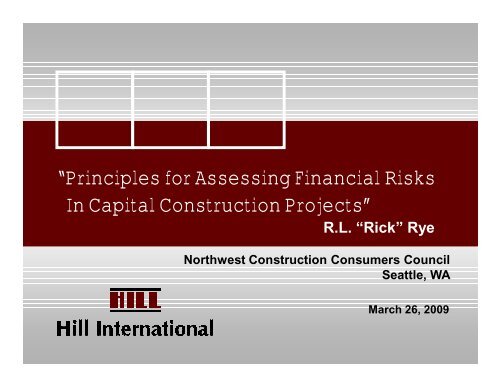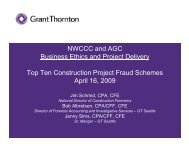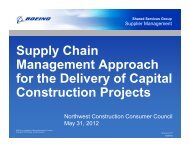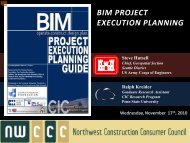NWCCC_Rick Rye Assessing Financial Risks in Capital ...
NWCCC_Rick Rye Assessing Financial Risks in Capital ...
NWCCC_Rick Rye Assessing Financial Risks in Capital ...
You also want an ePaper? Increase the reach of your titles
YUMPU automatically turns print PDFs into web optimized ePapers that Google loves.
“Pr<strong>in</strong>ciples for <strong>Assess<strong>in</strong>g</strong> <strong>F<strong>in</strong>ancial</strong> <strong>Risks</strong><br />
In <strong>Capital</strong> Construction Projects”<br />
R.L. “<strong>Rick</strong>” <strong>Rye</strong><br />
Northwest Construction Consumers Council<br />
Seattle, WA<br />
March 26, 2009
Introduction<br />
■ Risk is the chance that someth<strong>in</strong>g will happen<br />
chang<strong>in</strong>g the expected outcome of the project.<br />
-consequence that are undesirable<br />
-loss, damage, <strong>in</strong>juries, failures<br />
-loss of opportunity (for achiev<strong>in</strong>g the project<br />
goals and objectives)
Introduction<br />
■ Risk types hav<strong>in</strong>g an effect on the projects<br />
-safety risks<br />
-professional liabilities<br />
-environmental risks<br />
-contract risks<br />
-builders risks<br />
-economic risks<br />
-security risks<br />
■ <strong>F<strong>in</strong>ancial</strong> and cost change<br />
-manage at best<br />
time<br />
cost<br />
scope def<strong>in</strong>ition
Introduction<br />
Risk and benefits opportunities assessment matrix<br />
High<br />
<strong>Risks</strong><br />
Low<br />
Quadrant I<br />
High <strong>Risks</strong><br />
Low Benefits<br />
Quadrant III<br />
Low <strong>Risks</strong><br />
Low Benefits<br />
Benefits<br />
Quadrant II<br />
High <strong>Risks</strong><br />
High Benefits<br />
Quadrant IV<br />
Low <strong>Risks</strong><br />
High Benefits<br />
High
Introduction<br />
■ Survey and study of project performance<br />
40 projects range from<br />
$300 million to $8.2 billion<br />
■ Technical capacity exist<br />
■ Abundance of processes, plans, tools, and<br />
techniques (more available and use today than ever)<br />
■ Strik<strong>in</strong>g poor performance
Introduction<br />
<strong>Capital</strong> construction budget overruns for U.S. mega-projects<br />
Transit Facility<br />
Commuter Rail Bridge<br />
Highway Bridge<br />
Rail Expansion<br />
New Rail Technology<br />
Highway Improvements<br />
175%<br />
155%<br />
140%<br />
120%<br />
89%<br />
no formal risk process<br />
75%<br />
Percent (%) of construction cost overrun above the orig<strong>in</strong>al basel<strong>in</strong>e budget.
Introduction<br />
<strong>Capital</strong> construction budget overruns for U.S. mega-projects<br />
Highway Improvement<br />
40% ($1.2 bil)<br />
Bridge Reconstruction<br />
25% ($1.2 bil)<br />
Highway Improvement<br />
20% ($750 mil)<br />
Rail Improvement<br />
12% ($700 mil)<br />
Rail Expansion<br />
Introduction<br />
■ Need for new methods and practices<br />
-reduc<strong>in</strong>g costs<br />
-improv<strong>in</strong>g performance<br />
■ Allow<strong>in</strong>g potential risks to go unmanaged or<br />
unaddressed<br />
■ Identify<strong>in</strong>g, understand<strong>in</strong>g, evaluat<strong>in</strong>g and<br />
mitigat<strong>in</strong>g risks<br />
implement risk management<br />
<strong>in</strong>tegrate risk management
Introduction<br />
Establish Project<br />
Goals and Objectives<br />
stages of risk<br />
management<br />
Develop and Execute<br />
Risk Management Plan<br />
Performance Measurement<br />
Risk Monitor<strong>in</strong>g<br />
and Control<br />
Risk Identification<br />
and Analysis<br />
Risk Response and<br />
Mitigation Strategy
Introduction<br />
Risk management pr<strong>in</strong>ciples<br />
Risk plann<strong>in</strong>g and management<br />
Be realistic when mak<strong>in</strong>g assumptions<br />
Gather project <strong>in</strong>formation and expert judgments<br />
Understand risk elements and their impacts<br />
Assess and analyze risks impacts<br />
Develop mitigation and cont<strong>in</strong>gency plans<br />
Synthesize all risks to determ<strong>in</strong>e total impact<br />
Integrate risk management process<br />
Seek clear, realistic, and reliable project metrics<br />
Implement a cont<strong>in</strong>uous risk management process
Introduction<br />
Risk management pr<strong>in</strong>ciples<br />
Risk plann<strong>in</strong>g and management<br />
Be realistic when mak<strong>in</strong>g assumptions<br />
Gather project <strong>in</strong>formation and expert judgments<br />
Understand risk elements and their impacts<br />
Assess and analyze risks impacts<br />
Develop mitigation and 50 cont<strong>in</strong>gency projects studied plans<br />
Synthesize all risks to determ<strong>in</strong>e total impact<br />
$150 billion is total expected cost<br />
Integrate risk management process<br />
Seek clear, realistic, and reliable project metrics<br />
Implement a cont<strong>in</strong>uous risk management process
Risk Plann<strong>in</strong>g<br />
■ Recognize the need for apply<strong>in</strong>g risk management<br />
processes upfront; dur<strong>in</strong>g the plann<strong>in</strong>g and<br />
pre-construction phase of the project development
Risk Plann<strong>in</strong>g<br />
■ Initiate the risk management process at the very<br />
beg<strong>in</strong>n<strong>in</strong>g of the project<br />
■ Keep a strategic perspectives<br />
1<br />
Focus on the high-risk issues and their<br />
impacts<br />
2<br />
Consistently assess the adequacy of the<br />
mitigations and cont<strong>in</strong>gencies
Risk Plann<strong>in</strong>g<br />
Overall strategy of the risk management program<br />
Strategic Risk Process<br />
Successful Project<br />
Risk Plann<strong>in</strong>g<br />
■ <strong>Capital</strong> Construction Risk Management Plan<br />
-summarize key def<strong>in</strong>itions and risk<br />
term<strong>in</strong>ology (common language)<br />
-construct the framework for how the risk<br />
management process will work<br />
-establish program and process policies<br />
(organizational structure)<br />
-document risk identification and mitigation<br />
methods through risk allocation<br />
-clearly identify each stage of the process<br />
(uniform and cont<strong>in</strong>uous process)<br />
builds confidence
Risk Plann<strong>in</strong>g<br />
A cont<strong>in</strong>uous process for risk strategy and management<br />
Establish Project Strategy and Objectives<br />
Identify and Assess<br />
<strong>Risks</strong><br />
Focus on<br />
High Risk<br />
Issues and<br />
their Impacts<br />
Monitor/Review<br />
Performance<br />
Analysis Adequacy<br />
Mitigate Risk<br />
of Budget /Schedule<br />
1 2<br />
Assess<br />
Adequacy<br />
of the Mitigation<br />
and Cont<strong>in</strong>gencies<br />
Manage Project/<br />
Mitigate Risk<br />
An iterative and cont<strong>in</strong>uous process for manag<strong>in</strong>g risk as it changes and shifts.
Be Realistic When Mak<strong>in</strong>g Project<br />
Assessments and Assumptions<br />
■ Don’t allow the project assumptions to be <strong>in</strong>terpreted<br />
<strong>in</strong> too idealistic manner; <strong>in</strong>fluenc<strong>in</strong>g false th<strong>in</strong>k<strong>in</strong>g<br />
that everyth<strong>in</strong>g is go<strong>in</strong>g well
Be Realistic <strong>in</strong> Project Assumptions<br />
■ Everyth<strong>in</strong>g go<strong>in</strong>g accord<strong>in</strong>g to plan (EGAP)<br />
■ EGAP characteristically means<br />
-no major problems to draw management<br />
attention<br />
-no major project technical issues; i.e.,<br />
geological, environmental, contracts, etc.<br />
-all political, economic, and adm<strong>in</strong>istrative<br />
commitments and promises are kept<br />
-no apparent change <strong>in</strong> achiev<strong>in</strong>g the expected<br />
results<br />
EGAP –a fatal flaw
Be Realistic <strong>in</strong> Project Assumptions<br />
■ Major causes of known risks<br />
-design and specification changes<br />
-geological, natural elements, problems, etc.<br />
-resource shortages i.e., manpower, material, etc.<br />
-exist<strong>in</strong>g conditions<br />
■ Major causes of unidentified risks<br />
-lack of realism <strong>in</strong> cost forecast<br />
-underestimat<strong>in</strong>g the impact of risks<br />
-underestimat<strong>in</strong>g the corrections and actions
Gather Risk Information and Expert<br />
Judgments<br />
■ Gather as much <strong>in</strong>formation about the project as<br />
feasible. Use experts to help def<strong>in</strong>e questionable<br />
issues. Remove biased views from assessments<br />
and analysis
Gather Risk Information and Expert Judgment<br />
■ Work sessions to discuss methods of a risk analysis<br />
process<br />
-discuss methods of a risk analysis process and<br />
ga<strong>in</strong> consensus<br />
■ Gather risk <strong>in</strong>formation<br />
-<strong>in</strong>terviews<br />
-risk review meet<strong>in</strong>gs<br />
-workshops<br />
■ -CII Advanced Plann<strong>in</strong>g Risk Analysis<br />
collect<strong>in</strong>g group judgment<br />
BOGSAT
Understand <strong>Risks</strong> Elements and Their<br />
Impacts<br />
■ Identify and clarify specific risks and their potential<br />
impacts early <strong>in</strong> the project plann<strong>in</strong>g and development
Understand<strong>in</strong>g <strong>Risks</strong> Impacts<br />
STRATEGIC<br />
Means to Execute<br />
-Organization<br />
-Resources<br />
-Viability<br />
-Preconditions<br />
TECHNICAL<br />
Project Execution<br />
-Design<br />
-Eng<strong>in</strong>eer<strong>in</strong>g<br />
-Construction<br />
-Construction<br />
Management<br />
COST/SCHEDULE<br />
Manage Cost/Schedule<br />
-Earned Values<br />
-Cont<strong>in</strong>gency<br />
-Schedule Assessment<br />
RISK REGISTER<br />
Risk Assessment<br />
Risk Response and Mitigation
Understand<strong>in</strong>g <strong>Risks</strong> Impacts<br />
Risk register with risk evaluation criteria and remarks<br />
Project Risk Management Register
Understand<strong>in</strong>g <strong>Risks</strong> Impacts<br />
Risk register with risk evaluation criteria and remarks<br />
be specific<br />
be def<strong>in</strong>itive
Understand<strong>in</strong>g <strong>Risks</strong> Impacts<br />
Risk register with risk evaluation criteria and remarks<br />
capture the early th<strong>in</strong>k<strong>in</strong>g<br />
first thoughts on mitigation
Assess and Analyze <strong>Risks</strong> Impacts<br />
■ Evaluate and analyze all risks elements to the po<strong>in</strong>t<br />
of determ<strong>in</strong><strong>in</strong>g the degree of their impacts on the<br />
project goals and objectives
Assess and Analyze <strong>Risks</strong> Impacts<br />
■ Logical way of assess<strong>in</strong>g and measur<strong>in</strong>g potential<br />
impacts<br />
-evaluation of risk events or opportunities<br />
■ Two major approaches to logical risk analysis<br />
-determ<strong>in</strong>istic approach<br />
-probabilistic analysis<br />
supported by exist<strong>in</strong>g systems<br />
statistical analysis and model<strong>in</strong>g
Assess and Analyze <strong>Risks</strong> Impacts<br />
SCHEDULING COST REPORTING WORK AUTHORIZATION<br />
■ Variance Analysis<br />
■ Performance Indicators<br />
■ Trends<br />
■ Rema<strong>in</strong><strong>in</strong>g Duration<br />
■ Physical Progress<br />
■ Activity Float<br />
■ Critical Paths<br />
■ Long-Lead Procurements<br />
■ Variance Analysis<br />
■ Performance Indicators<br />
■ Trends<br />
■ Cost/Pric<strong>in</strong>g Variances<br />
■ Estimate-to-Complete<br />
■ Estimate-at-Completion<br />
■ Total Costs<br />
■ Forecast Expenditures<br />
■ Current and Forecasted<br />
Commitments<br />
■ Work Authorization<br />
Commitments<br />
■ Expenditures and<br />
Commitments<br />
■ Material Stored<br />
■ Work-<strong>in</strong>-Place<br />
Collect<strong>in</strong>g Information and Data<br />
earned value measurement<br />
Analysis and Interpret<strong>in</strong>g the Expected Performance
Assess and Analyze <strong>Risks</strong> Impacts<br />
Performance Measurement<br />
Collect<strong>in</strong>g Information and Data<br />
Risk<br />
Analysis<br />
Process<br />
Analyz<strong>in</strong>g and Interpret<strong>in</strong>g the Expected Performance<br />
statistical analysis and model<strong>in</strong>g<br />
Risk Register
Assess and Analyze <strong>Risks</strong> Impacts<br />
■ Use risk evaluation scor<strong>in</strong>g to assign values to risks<br />
-numerical <strong>in</strong>terpretation for analysis<br />
■ Risk event status<br />
-probability of occurrence (likelihood of the<br />
event happen<strong>in</strong>g<br />
-severity of impact (cost or time at stake)<br />
risk event status =<br />
risk probability X amount at stake =
Assess and Analyze <strong>Risks</strong> Impacts<br />
Risk evaluation scor<strong>in</strong>g criteria for the probability of<br />
occurrence to the likelihood of occurrence<br />
Correlation between qualitative description and the quantitative metric
Assess and Analyze <strong>Risks</strong> Impacts<br />
Risk evaluation scor<strong>in</strong>g criteria for f<strong>in</strong>ancial exposure<br />
to severity of impact<br />
<strong>F<strong>in</strong>ancial</strong> Exposure<br />
Severity<br />
Up to $10,000 1 M<strong>in</strong>or<br />
Up to $250,000 2 Moderate<br />
Up to $500,000 3 Serious<br />
Up to $1 million 4 Major<br />
Over $1 million 5 Critical<br />
Associat<strong>in</strong>g severity measurements to potential f<strong>in</strong>ancial impacts or variations
Assess and Analyze <strong>Risks</strong> Impacts<br />
Risk register with risk evaluation scor<strong>in</strong>g and remarks<br />
Project Risk Management Register<br />
4 5<br />
Critical<br />
rely<strong>in</strong>g on judgment (expert)<br />
risk event status
Assess and Analyze <strong>Risks</strong> Impacts<br />
Top 10 impact risks priorities –the “Watch” list;<br />
1. Compressed design schedule<br />
2. Lack of timely decisions and <strong>in</strong>formation flow<br />
3. Changes <strong>in</strong> design criteria and scope<br />
4. Environmental plann<strong>in</strong>g and impacts (NEPA)<br />
5. Very tight security requirements<br />
6. Lack of available resources<br />
7. Logistics problems<br />
8. Unique technology and <strong>in</strong>novative design<br />
9. Release for property access<br />
10. Construction critical path impacts<br />
Critical<br />
Critical<br />
Major<br />
Major<br />
Major<br />
Serious<br />
Serious<br />
Serious<br />
Moderate<br />
Moderate
Mitigation and Cont<strong>in</strong>gency Plann<strong>in</strong>g<br />
■ Develop mitigation and cont<strong>in</strong>gency plans that are<br />
sufficient for the priority or the degree of impact<br />
associated with the risk
Develop Mitigation and Cont<strong>in</strong>gency Plans<br />
Risk Management Plann<strong>in</strong>g<br />
Risk Identification<br />
Qualitative and Quantitative<br />
Risk Analysis<br />
Risk Monitor<strong>in</strong>g and Control<br />
-monitor and evaluate<br />
-revisions, re-basel<strong>in</strong>e, updates<br />
-report<strong>in</strong>g and communicat<strong>in</strong>g<br />
Avoidance<br />
Risk Response and Mitigation Actions<br />
Mitigation<br />
Transfer<br />
Acceptance<br />
Cost of Risk Management
Develop<strong>in</strong>g Mitigation Mitigation and Plans Cont<strong>in</strong>gency Plans<br />
■ <strong>Risks</strong> responses and mitigations strategies <strong>in</strong>clude<br />
options such as<br />
-control measures<br />
- management actions<br />
-contractual arrangements<br />
-third party i.e. contractors, <strong>in</strong>surance, etc.<br />
-resource provisions<br />
-cont<strong>in</strong>gency and reserve funds<br />
determ<strong>in</strong>e effectiveness <strong>in</strong> actions<br />
mitigations actions cost
Develop Mitigation and Cont<strong>in</strong>gency Plans<br />
■ Cont<strong>in</strong>gency is typically an <strong>in</strong>tegral part of budget<br />
estimat<strong>in</strong>g<br />
-an arbitrary value<br />
-when added to the base estimate, or schedule,<br />
for unknowns<br />
-when used to offset unclear or unknown issues<br />
cont<strong>in</strong>gencies overestimated of underestimated
Develop Mitigation and Cont<strong>in</strong>gency Plans<br />
Risk response strategies and options profile and ledger<br />
multiple options<br />
be specific and realistic
Develop Mitigation and Cont<strong>in</strong>gency Plans<br />
■ Risk response actions have a resource value<br />
-cost (budget or cont<strong>in</strong>gency)<br />
-time (budget or float)<br />
■ Not cost effective to mitigate all risks<br />
-adequate cont<strong>in</strong>gencies and reserves<br />
■ Logical vehicle for predict<strong>in</strong>g the extent of variations<br />
-forecast<strong>in</strong>g the best case scenarios and worst case<br />
scenarios<br />
worst case<br />
most unpopular
Develop Mitigation and Cont<strong>in</strong>gency Plans<br />
Probability distribution represent<strong>in</strong>g variations of<br />
probable occurrence<br />
Expected Values<br />
@RISK add-<strong>in</strong>s<br />
normal distribution<br />
statistical mean<br />
10% 25% 50% 75% 90%<br />
Probabilities
Develop Mitigation and Cont<strong>in</strong>gency Plans<br />
Risk Register<br />
(Cost/Schedule)<br />
Statistical Analysis<br />
(@RISK)<br />
Statistical Assessment<br />
-Statistical Methods<br />
-@ Risk<br />
Potential Changes to<br />
Present Estimate<br />
Labor costs are expected to vary due to<br />
changes <strong>in</strong> quantities, productivity or rates<br />
Probability<br />
Matrix
Develop Mitigation and Cont<strong>in</strong>gency Plans<br />
Mitigation model and range estimat<strong>in</strong>g with probability<br />
budget elements<br />
event and scope elements
Develop Mitigation and Cont<strong>in</strong>gency Plans<br />
Risk Register<br />
(Cost/Schedule)<br />
Statistical Analysis<br />
(@RISK)<br />
Statistical Assessment<br />
-Statistical Methods<br />
-@ Risk<br />
Potential Changes to<br />
Present Estimate<br />
Labor costs are expected to vary due to<br />
changes <strong>in</strong> quantities, productivity or rates<br />
Cost Probability<br />
Matrix
Develop Mitigation and Cont<strong>in</strong>gency Plans<br />
Risk Register<br />
(Cost/Schedule)<br />
Statistical Analysis<br />
(@RISK)<br />
(Crystal Ball)<br />
Cost <strong>Risks</strong> Report<br />
Estimated<br />
Cost<br />
$3.10 M<br />
P<br />
15%<br />
Low<br />
High<br />
$2.67 M $3.78 M<br />
Cost Probability<br />
Matrix<br />
confidence level
Develop Mitigation and Cont<strong>in</strong>gency Plans<br />
Risk Register<br />
(Cost/Schedule)<br />
Schedule<br />
Documents<br />
Simulations<br />
(PertMaster)<br />
Schedule <strong>Risks</strong> Report<br />
Estimated<br />
Days<br />
P<br />
Low<br />
High<br />
220<br />
15%<br />
210 240
Synthesiz<strong>in</strong>g the <strong>Risks</strong><br />
■ Synthesiz<strong>in</strong>g all potential project risks and determ<strong>in</strong>e<br />
the total cumulative effect
Synthesiz<strong>in</strong>g the <strong>Risks</strong><br />
■ Determ<strong>in</strong>istic evaluation has limits<br />
■ Develop a logical model for overall project risks<br />
measurement to mitigate and manage<br />
■ Probabilistic methods for overall statistical<br />
model analysis and simulation<br />
-determ<strong>in</strong>e that the mitigation costs is adequate<br />
-giv<strong>in</strong>g expectations that the project will meet<br />
objectives<br />
-help provide confidence <strong>in</strong> the expected<br />
project cost<br />
@RISK analysis<br />
PertMaster
Synthesiz<strong>in</strong>g the <strong>Risks</strong><br />
Cumulative probability distribution curves
Synthesiz<strong>in</strong>g the <strong>Risks</strong><br />
Project cost cont<strong>in</strong>gency analysis probability of occurrence<br />
<strong>Capital</strong> Construction Project X<br />
Probability of Underrun (%)<br />
100%<br />
90%<br />
80%<br />
70%<br />
60%<br />
50%<br />
40%<br />
30%<br />
20%<br />
10%<br />
0%<br />
P10<br />
$650,213<br />
$661,608<br />
P50<br />
$668,917<br />
$675,644<br />
P90<br />
$681,200<br />
$685,838<br />
$689,898<br />
$694,133<br />
$698,622<br />
$702,890<br />
$640,000 $660,000 $680,000 $700,000 $720,000 $740,000 $760,000 $780,000<br />
Total Project Cost ($000)<br />
$707,047<br />
$711,635<br />
$716,101<br />
$721,131<br />
$726,467<br />
$732,532<br />
$739,549<br />
$749,464<br />
$761,766
Synthesiz<strong>in</strong>g the <strong>Risks</strong><br />
Project cost cont<strong>in</strong>gency analysis probability of occurrence<br />
Probability of Underrun (%)<br />
100%<br />
90%<br />
80%<br />
70%<br />
60%<br />
50%<br />
40%<br />
30%<br />
20%<br />
10%<br />
0%<br />
P10<br />
$650,213<br />
$661,608<br />
<strong>Capital</strong> Construction Project X<br />
P50<br />
$668,917<br />
$675,644<br />
P90<br />
$681,200<br />
$685,838<br />
$726,467<br />
$721,131<br />
actual project budget: $750 M<br />
$716,101<br />
$707,047<br />
$702,890<br />
adequate project budget: $750 M<br />
$698,622<br />
(90% $694,133 probability of underrun)<br />
$689,898<br />
$640,000 $660,000 $680,000 $700,000 $720,000 $740,000 $760,000 $780,000<br />
Total Project Cost ($000)<br />
$711,635<br />
$732,532<br />
$739,549<br />
$749,464<br />
$761,766
Synthesiz<strong>in</strong>g the <strong>Risks</strong><br />
Project cost cont<strong>in</strong>gency analysis probability of occurrence<br />
Probability of Underrun (%)<br />
100%<br />
90%<br />
80%<br />
70%<br />
60%<br />
50%<br />
40%<br />
30%<br />
20%<br />
10% P10<br />
0%<br />
<strong>Capital</strong> Construction Project Y<br />
P90<br />
P50<br />
$455.0<br />
$447.6<br />
$442.5<br />
$438.6<br />
$434.9<br />
$431.7<br />
$428.9<br />
$426.3<br />
actual $423.8 project budget: $400 M<br />
$421.2<br />
$418.6<br />
$416.2<br />
$413.7<br />
adequate project budget: $448 M<br />
$410.9<br />
$407.9<br />
(90% probability of underrun)<br />
$404.6<br />
$400.5<br />
$395.7<br />
$388.9<br />
$380 $390 $400 $410 $420 $430 $440 $450 $460<br />
Total Project Cost ($millions)
Synthesiz<strong>in</strong>g the <strong>Risks</strong><br />
Project cost cont<strong>in</strong>gency analysis probability of occurrence<br />
Probability of Underrun (%)<br />
<strong>Capital</strong> Construction Project Z<br />
100%<br />
P90<br />
$192,545<br />
90%<br />
$188,555<br />
$185,387<br />
80%<br />
$182,879<br />
$180,683<br />
70%<br />
$178,665<br />
$176,889<br />
60%<br />
$175,042<br />
P50<br />
actual<br />
$173,579<br />
project budget: $187 M<br />
50%<br />
$172,038<br />
$170,647<br />
40%<br />
$169,245<br />
$167,892<br />
30%<br />
$166,542 adequate project budget: $189 M<br />
20%<br />
$165,232<br />
$163,680 (90% probability of underrun)<br />
P10<br />
$161,772<br />
10%<br />
$159,665<br />
$156,589<br />
0%<br />
$150,000 $155,000 $160,000 $165,000 $170,000 $175,000 $180,000 $185,000 $190,000 $195,000<br />
Total Project Cost ($000)
Probability of Underrun (%)<br />
Synthesiz<strong>in</strong>g the <strong>Risks</strong><br />
Project schedule cont<strong>in</strong>gency analysis probability of occurrence<br />
<strong>Capital</strong> Construction Project Z<br />
100%<br />
90%<br />
80%<br />
70%<br />
60%<br />
50%<br />
40%<br />
30%<br />
20%<br />
10%<br />
0%<br />
P10<br />
P50<br />
P90<br />
1.88<br />
3.65<br />
3.52<br />
project CPM 3.40 schedule float: 0 months<br />
3.26<br />
3.02<br />
2.90<br />
2.78<br />
(90% 2.65 probability of underrun)<br />
2.50<br />
2.35<br />
2.15<br />
3.14<br />
3.78<br />
3.93<br />
4.09<br />
4.59<br />
4.31<br />
- 1.00 2.00 3.00 4.00 5.00 6.00<br />
Scheduled Time (Months)<br />
5.03<br />
adequate schedule float: 5 months
Synthesiz<strong>in</strong>g the <strong>Risks</strong><br />
Project risk-based mitigation cost cont<strong>in</strong>gency<br />
Mitigation Cost Profile with Probabilities<br />
Current<br />
Estimate<br />
Project Cost<br />
w/o Risk<br />
Process<br />
Mitigation Cost<br />
and Cont<strong>in</strong>gency<br />
Expected<br />
Total Project Costs<br />
$1,668.36 $365.59 21.9% $2,033.95<br />
P10 $1,668.36 $178.64 10.7% $1,847.00<br />
Mean $1,668.36 $373.07 22.4% $2,041.43<br />
P90 $1,668.36 $570.84 34.2% $2,239.2<br />
Dollar values represent millions ($000)
Synthesiz<strong>in</strong>g the <strong>Risks</strong><br />
■ Benefits of probabilistic cont<strong>in</strong>gency models and<br />
simulations<br />
-provides explicit <strong>in</strong>formation for mak<strong>in</strong>g<br />
<strong>in</strong>formed decisions<br />
-assist <strong>in</strong> the overall predictability for<br />
meet<strong>in</strong>g the owners expectations<br />
measure adequacy of resource cont<strong>in</strong>gencies<br />
to the best of our judgment
Integrate the <strong>Risks</strong> Management Process<br />
■ Integrate the risk management process with<br />
the day-to-day construction project management<br />
applications
Integrate the <strong>Risks</strong> Management Process<br />
■ Major objectives of <strong>in</strong>tegrated risk management<br />
approach<br />
-<strong>in</strong>tegrat<strong>in</strong>g mitigation plann<strong>in</strong>g before the<br />
consequence (feedback)<br />
-enhanc<strong>in</strong>g the identification of resources for<br />
project management<br />
-facilitat<strong>in</strong>g cont<strong>in</strong>uous monitor<strong>in</strong>g, analysis<br />
and communication<br />
collaborated<br />
<strong>in</strong>tegrated
Integrate the <strong>Risks</strong> Management Process<br />
Integrated risk management process<br />
Develop and Execute<br />
Risk Management Plan<br />
Performance Measurement<br />
Risk Monitor<strong>in</strong>g<br />
and Control<br />
Risk Identification<br />
and Analysis<br />
Risk Response and<br />
Mitigation Strategy<br />
Total dependency upon the normal performance control system
Rely on Clear and Reliable Project<br />
Metrics<br />
■ Ensure clear, realistic, and reliable def<strong>in</strong>ition of the<br />
project performance measurements and metrics
Reliable Measurements and Metrics<br />
■ Common problem<br />
■ Predictable world of cause and effects<br />
■ Major cause of project variances<br />
-lack of realism <strong>in</strong> <strong>in</strong>itial plann<strong>in</strong>g and def<strong>in</strong>ition<br />
-delays underestimated<br />
-cont<strong>in</strong>gencies too low<br />
-geological and natural elements not clearly<br />
def<strong>in</strong>ed<br />
-environmental, safety and exist<strong>in</strong>g conditions<br />
unclear<br />
can’t measure, can’t manage
Implement a Cont<strong>in</strong>uous Risk<br />
Management Process<br />
■ Cont<strong>in</strong>uously evaluate the effects of risks through the<br />
progress of the project work and <strong>in</strong>terven<strong>in</strong>g when<br />
necessary to ensure their mitigation and resolution
A Cont<strong>in</strong>uous Risk Process<br />
■ Identify<strong>in</strong>g additional risks as the project<br />
progresses<br />
■ Cont<strong>in</strong>uously gather<strong>in</strong>g risk <strong>in</strong>formation and<br />
conduct<strong>in</strong>g reviews as the project progresses<br />
-reevaluat<strong>in</strong>g risks periodically<br />
-evaluations at the end of each milestone phase<br />
■ Cont<strong>in</strong>uously assess<strong>in</strong>g the probability of<br />
occurrence and potential impact<br />
<strong>in</strong>crease budget confidence<br />
<strong>in</strong>crease success confidence
A Cont<strong>in</strong>uous Risk Process<br />
Cont<strong>in</strong>u<strong>in</strong>g risk analysis with project management<br />
Appo<strong>in</strong>t Project Risk Manager<br />
And Convene Project Risk Team<br />
Conduct Prelim<strong>in</strong>ary Risk<br />
Identification And Assessment<br />
Risk Allocation<br />
Performance Measurement<br />
Evaluate Effectiveness of Mitigation<br />
Strategies and Actions<br />
Set-up Risk Register and Break<br />
Project Down <strong>in</strong>to Sections<br />
Perform Qualitative<br />
Risk Assessments<br />
Perform Quantitative<br />
Risk Assessments<br />
Identify<br />
New Risk and Record <strong>in</strong><br />
Risk Register<br />
Project Execution and Construction
Conclusion<br />
■ <strong>Risks</strong> cannot be elim<strong>in</strong>ated<br />
■ <strong>Risks</strong> can be acknowledged and managed <strong>in</strong> a<br />
better method<br />
-measured and expressed a great deal<br />
better
Conclusion<br />
■ Th<strong>in</strong>k <strong>in</strong> terms of the follow<strong>in</strong>g<br />
-hav<strong>in</strong>g a risk management process<br />
-identify risks elements and determ<strong>in</strong>e their<br />
effects<br />
-assign mitigation actions and strategies<br />
-use as another project management tool kit<br />
keep watch on top risks<br />
monitor and track performance results
A Cont<strong>in</strong>uous Risk Process<br />
An iterative and cont<strong>in</strong>uous measur<strong>in</strong>g and evaluation<br />
process<br />
Establish Project Strategy and Objectives<br />
1 2<br />
Focus on<br />
High Risk<br />
Issues and<br />
Their Impacts<br />
Monitor/Review<br />
Performance<br />
Identify and Assess<br />
<strong>Risks</strong><br />
Manage Project/<br />
Mitigate Risk<br />
Analyze Adequacy<br />
Mitigate Risk<br />
of Budget /Schedule<br />
Assess<br />
Adequacy<br />
of the Mitigation<br />
and Cont<strong>in</strong>gencies
Conclusion<br />
■ Benefits of the risk management process<br />
-discipl<strong>in</strong>ed framework<br />
-avoided/reduced large losses<br />
-improved decision mak<strong>in</strong>g<br />
-improved allocation of resources<br />
-<strong>in</strong>creased project confidence<br />
best method for owners <strong>in</strong>terest protected<br />
risks are balanced to adequate mitigation
Questions and Comments<br />
R.L. “<strong>Rick</strong>” <strong>Rye</strong><br />
Senior Vice President<br />
Texas Regional Manager<br />
Hill International, Inc.<br />
5307 E. Mock<strong>in</strong>gbird Lane, Suite 700<br />
Dallas, TX 75206<br />
214-220-0180<br />
richardrye@hill<strong>in</strong>tl.com



![IPA Engineering Trends 1.ppt [Compatibility Mode] - NWCCC](https://img.yumpu.com/24838956/1/190x146/ipa-engineering-trends-1ppt-compatibility-mode-nwccc.jpg?quality=85)

![NWCCC ASME B30 03312010.ppt [Read-Only] [Compatibility Mode]](https://img.yumpu.com/24838901/1/190x146/nwccc-asme-b30-03312010ppt-read-only-compatibility-mode.jpg?quality=85)




